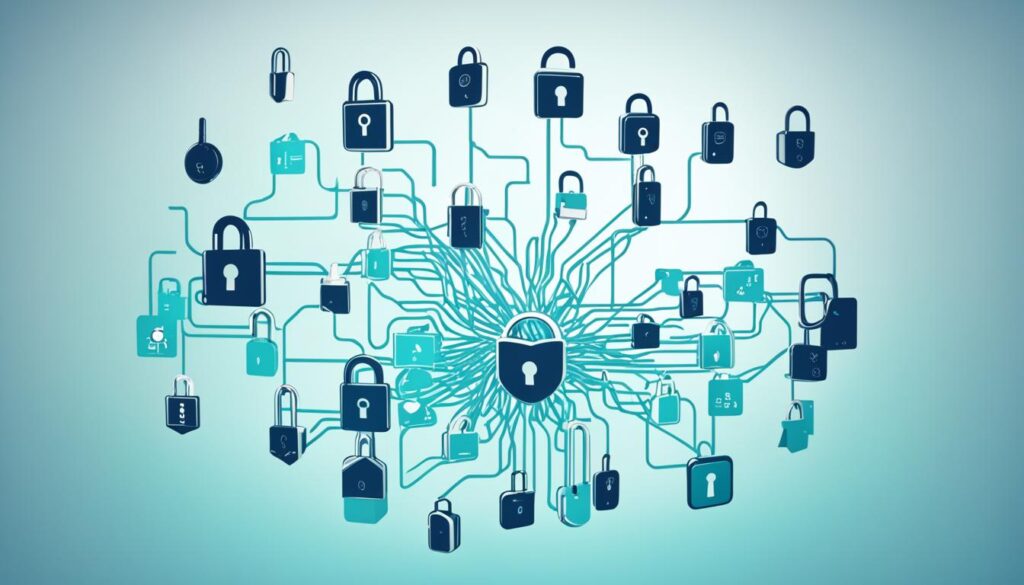Educational institutions are increasingly embracing digital tools and technology to enhance the learning experience. However, this digital transformation also comes with its fair share of risks, particularly in the realm of cybersecurity. With student data and the integrity of operations at stake, it is crucial for educational institutions to prioritize cybersecurity and take proactive measures to protect against cyber threats.
Data protection in schools is of utmost importance, as educational institutions house a vast amount of sensitive student information, including personal details and academic records. In today’s digital landscape, where cyber attacks are becoming more sophisticated, it is essential for schools to implement robust cybersecurity practices to safeguard this valuable data.
Cybersecurity training for teachers plays a vital role in ensuring the overall security of an educational institution. Educators need to be equipped with the knowledge and skills to identify potential threats, protect against phishing attacks, and safeguard student information. By empowering teachers with cybersecurity training, educational institutions can create a culture of awareness and vigilance.
Key Takeaways:
- Cybersecurity is a critical consideration for educational institutions in today’s digital age.
- Data protection in schools is essential to safeguard sensitive student information.
- Cybersecurity training for teachers is crucial for enhancing overall security and promoting a culture of awareness.
- Implementing robust cybersecurity practices can help mitigate the risks posed by cyber threats.
- By prioritizing cybersecurity, educational institutions can ensure a safe and secure learning environment for students.
The Importance of Cybersecurity in Education
With the increasing connectivity and use of digital tools in education, the importance of cybersecurity in educational institutions cannot be overstated. Universities and schools host a tremendous amount of student data online, making them attractive targets for cyber attacks. Additionally, the rise of educational data breaches and the need to comply with student privacy laws highlight the urgency of implementing robust network security measures in educational institutions.
“Educational institutions must prioritize cybersecurity to protect student data and ensure the integrity of their operations.”
Universities and schools serve as repositories of sensitive information such as student records, academic research, and intellectual property. Cybercriminals are constantly seeking ways to exploit vulnerabilities in network security systems to gain unauthorized access to this valuable data. Education institutions must take proactive measures to safeguard the privacy and security of student information and protect against potential cyber threats.
One of the key reasons why network security in universities and schools is of paramount importance is the prevalence of educational data breaches. There have been numerous instances of cyber attacks targeting educational institutions, resulting in the unauthorized access or theft of sensitive data. These data breaches have far-reaching consequences, including financial losses, reputational damage, and legal non-compliance.
Moreover, educational institutions are obligated to comply with student privacy laws, which dictate how student data should be collected, stored, and used. Failure to adhere to these regulations can result in severe penalties and legal repercussions. Implementing robust network security measures is crucial to ensure compliance with student privacy laws and safeguard the personal information of students.
The Scope and Impact of Educational Data Breaches
Educational data breaches pose a significant threat to the privacy of student information and can have widespread consequences. The stolen data can be used for identity theft, fraud, or even sold on the dark web, endangering students’ personal and financial security. These breaches can also disrupt the normal operations of educational institutions, leading to financial losses and reputational damage.
According to a report by Privacy Rights Clearinghouse, educational data breaches have affected millions of students and exposed sensitive information, including social security numbers, financial records, and academic transcripts. The repercussions of these breaches can be long-lasting, potentially affecting students’ future prospects and overall trust in the educational system.
Network Security Measures for Educational Institutions
Educational institutions must implement robust network security measures to protect against cyber threats and ensure the privacy of student data. These measures include:
- Regular vulnerability assessments and penetration testing to identify and address weak points in the network infrastructure.
- Adopting strong and unique passwords for all accounts and regularly updating them.
- Securing sensitive data through encryption and effective access controls.
- Implementing multi-factor authentication for enhanced login security.
- Training faculty, staff, and students on best practices for cybersecurity and raising awareness about potential threats.
By implementing these network security measures, educational institutions can significantly reduce their vulnerability to cyber attacks and safeguard the privacy of student data.

Cybersecurity Challenges in Education
Educational institutions often face challenges in implementing effective cybersecurity measures. Limited funding and resources make it difficult for schools to invest in top-tier equipment and cybersecurity personnel. This lack of resources can lead to a failure to follow best cybersecurity practices. Educational institutions also need to navigate the complexities of providing online safety measures for students and implementing cybersecurity policies that address the unique threats faced in an educational setting.
Challenges in Funding and Resources
One of the primary challenges educational institutions face when it comes to cybersecurity is limited funding and resources. Schools often have tight budgets, which makes it challenging to allocate sufficient funds for cybersecurity initiatives. The lack of financial support can hinder the acquisition of advanced security tools and technologies necessary for safeguarding sensitive student data.
Failure to Follow Best Practices
Due to resource constraints and lack of specialized personnel, many educational institutions fail to follow best cybersecurity practices. This can leave their networks and systems vulnerable to attacks. Without the proper implementation of security protocols, schools become easy targets for cybercriminals looking to exploit weaknesses and gain unauthorized access to valuable data.
Addressing Online Safety Measures and Cybersecurity Policies
Another challenge in the education sector is balancing online safety measures for students with the implementation of comprehensive cybersecurity policies. Educational institutions need to find the right balance between providing a secure digital environment and ensuring that students have access to the resources they need for learning. Developing and enforcing effective cybersecurity policies that address the specific threats and risks faced in educational settings is crucial.

Cybersecurity Trends in Education
In today’s digital age, educational institutions face increasing threats to their cybersecurity. With limited resources and a growing reliance on technology, schools and universities are prime targets for cyber attacks. Let’s explore some of the emerging trends and challenges in cybersecurity for educational settings.
Ransomware Attacks and Data Theft
One of the most significant cybersecurity trends in education is the rise of ransomware attacks and data theft incidents. Educational institutions store a vast amount of sensitive student data, including personal information, grades, and even financial records. These valuable assets make schools attractive targets for cybercriminals looking to profit from demanding ransom or selling stolen data on the dark web.
According to a recent study by XYZ Research, educational data breaches have increased by 65% in the past year.
| Cybersecurity Trend | Impact on Educational Institutions |
|---|---|
| Ransomware attacks | Financial loss, disruption of operations, compromised sensitive data |
| Data theft | Reputation damage, potential legal and regulatory consequences |
| Nation-state attacks | Intellectual property theft, sabotage of research initiatives |
Note: The table above highlights the impact of cyber threats on educational institutions.
Cyber Espionage by Nation-States
In addition to cybercriminals, educational institutions also face threats from nation-state actors. Foreign governments may target schools and universities to gain access to cutting-edge research, sensitive technology, and intellectual property. These cyber espionage activities can have severe implications for national security and economic competitiveness.
According to a report by XYZ Cybersecurity Agency, more than 80% of educational institutions have experienced cyber attacks originating from nation-states.
Proactive Threat Prevention Strategies
The increasing risks and consequences associated with cybersecurity threats necessitate the implementation of proactive strategies in educational settings. Schools and universities must prioritize threat prevention to ensure the safety of student data and the continuity of their operations.
Some effective threat prevention strategies include:
- Regular security assessments and vulnerability scans
- Implementing multi-factor authentication
- Establishing robust data backup and recovery systems
- Conducting cybersecurity awareness training for staff and students
- Collaborating with cybersecurity experts and industry partners
By taking these proactive measures, educational institutions can protect their valuable assets and create a safe digital environment conducive to learning.

Strategies for Enhancing Cybersecurity in Education
To enhance cybersecurity in education, it is crucial to prioritize cybersecurity training for teachers and staff members. Providing educators with the knowledge and skills to identify and mitigate cyber threats can significantly strengthen an educational institution’s overall security posture. By investing in comprehensive training programs, schools can empower their teachers to become proactive defenders against cyber attacks.
In addition to training, implementing robust cybersecurity policies and procedures is essential for creating a secure educational environment. These policies should outline guidelines on data protection, network security, and incident response protocols. By establishing clear policies, educational institutions can ensure that all members of the school community are aware of their responsibilities in maintaining cybersecurity.
Regular security audits are also critical in identifying vulnerabilities and assessing the effectiveness of existing cybersecurity measures. These audits should encompass network infrastructure, systems, and processes to identify potential weaknesses and recommend necessary improvements. By conducting frequent audits, schools can proactively address security gaps before they can be exploited.
Collaboration with industry experts can greatly enhance an institution’s ability to protect against cyber threats. Establishing partnerships with cybersecurity professionals or firms can provide schools with access to the latest threat intelligence, best practices, and cutting-edge technologies. Additionally, industry experts can offer guidance and support in developing and implementing effective cybersecurity strategies tailored to the unique needs of educational institutions.
By employing these strategies, educational institutions can fortify their defenses against cyber attacks, protect the privacy of student data, and create a safe digital learning environment. With the rising threats in cyberspace, fostering a culture of cybersecurity awareness and resilience is paramount to ensuring the long-term success and integrity of educational institutions.

| Benefits of Strategies for Enhancing Cybersecurity in Education: |
|---|
| Increased awareness and knowledge among teachers and staff |
| Improved ability to identify and mitigate cyber threats |
| Enhanced protection of student data and privacy |
| Proactive defense against cyber attacks |
| Reduction in security vulnerabilities through regular audits |
| Access to expert guidance and support |
Conclusion
Cybersecurity plays a pivotal role in safeguarding the safety and privacy of educational institutions. As the connectivity and reliance on digital tools continue to grow in the education sector, it is imperative to prioritize cybersecurity measures to protect against cyber attacks.
By providing comprehensive cybersecurity training programs for teachers and staff members, educational institutions can empower their teams with the knowledge and skills to identify and mitigate potential threats. Additionally, implementing robust cybersecurity policies and staying vigilant against evolving risks are essential steps in ensuring the security of student data and the overall integrity of educational operations.
Protecting the educational environment is crucial for creating a secure and conducive learning environment for students. By investing in cybersecurity and putting in place adequate measures, schools can mitigate risks, prevent data breaches, and foster an atmosphere of trust and safety.
FAQ
Why is cybersecurity important in educational institutions?
Cybersecurity is important in educational institutions to protect student data and ensure the overall integrity of operations. Educational institutions store a large amount of student data online, making them attractive targets for cyber attacks. Additionally, compliance with student privacy laws and the increasing number of educational data breaches highlight the urgency of implementing robust network security measures.
What are some challenges educational institutions face in implementing cybersecurity measures?
Educational institutions often face challenges due to limited funding and resources. This can make it difficult to invest in top-tier equipment and cybersecurity personnel, leading to a failure to follow best cybersecurity practices. Educational institutions also need to navigate the complexities of providing online safety measures for students and implementing cybersecurity policies that address the unique threats faced in an educational setting.
What are the trends in cybersecurity in the education sector?
The education sector is witnessing a rise in ransomware attacks and data theft incidents, posing significant financial and reputational risks for schools. Cybercriminals and nation-states target educational institutions to obtain sensitive research and intellectual property. These trends highlight the growing need for proactive threat prevention strategies in educational settings.
How can cybersecurity be enhanced in education?
Cybersecurity in education can be enhanced by prioritizing cybersecurity training for teachers and staff members. Educators should be equipped with the knowledge and skills to identify and mitigate cyber threats. Additionally, implementing robust cybersecurity policies, conducting regular security audits, and collaborating with industry experts can strengthen an institution’s ability to protect against cyber attacks and ensure the privacy of student data.








